- Privacy drives loyalty. Most users stay with a provider because they feel secure—not because it’s cheaper.
- Built-in privacy reduces churn. Providers offering privacy tools like VPN and encrypted DNS see fewer cancellations.
- Simple privacy wins. Many users drop services when privacy settings feel confusing or inconsistent.
- Privacy boosts revenue. Customers pay more for services they trust to protect their data.
- Fast deployment. With PureVPN White Label, telecoms can launch branded privacy bundles in weeks and improve retention fast.
Subscribers rarely leave a service they trust. In subscription-driven industries like broadband, mobile, and streaming, privacy has become the strongest trust signal. Users no longer renew because of price or speed; they stay because they feel protected.
For telecom providers, bundled privacy is proving to be a key factor in long-term telecom subscriber retention. When privacy tools like VPN, encrypted DNS, and secure browsing are included in service plans, users build deeper attachment to their provider. It is not only about adding value, it is about building trust that lasts.
The New Loyalty Driver – Privacy Over Price
A 2025 Deloitte survey found that over 60% of broadband and mobile users stay with a provider because they feel secure and respected, not because they pay less. This represents a major shift in how retention is earned.
Privacy has become an emotional loyalty factor. When customers believe their data is safe, they stop comparing plans and start believing in the brand.
What the Market Data Shows?
Most existing content about subscriber retention focuses on discounts or service quality. However, industry data now shows that privacy protection has a direct, measurable impact on churn reduction.
| Metric | Insight | Source |
| 60% of telecom users stay loyal when they trust data handling | Trust is now a bigger retention factor than price | Deloitte, 2025 |
| 74% of telecoms plan to add privacy bundles | Providers view privacy as a competitive edge | PwC, 2024 |
| 52% of broadband churn linked to data breaches | Secure privacy ecosystems lower churn rates | McKinsey, 2025 |
Many providers still underestimate this connection. Privacy is not just compliance; it is a retention strategy that directly strengthens the business model.
What “Bundled Privacy” Really Means for Subscribers?
Bundled privacy refers to a collection of integrated tools designed to protect users across every connection type, whether at home, on mobile networks, or through public Wi-Fi.
Core privacy bundle components
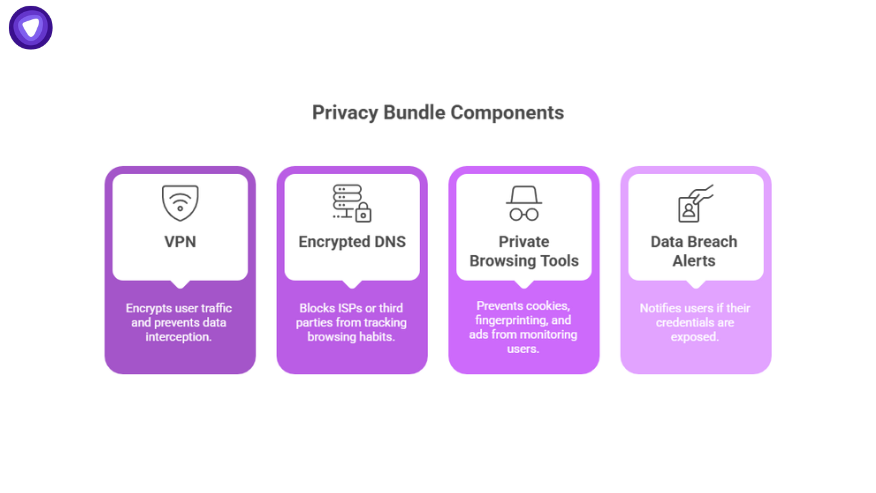
- VPN (Virtual Private Network) – Encrypts user traffic and prevents data interception.
- Encrypted DNS – Blocks ISPs or third parties from tracking browsing habits.
- Private Browsing Tools – Prevents cookies, fingerprinting, and ads from monitoring users.
- Data Breach Alerts – Notifies users if their credentials are exposed.
Subscribers do not want five separate apps for security. They want one unified experience. Bundled privacy simplifies the process, integrates with existing accounts, and removes friction.
The Integration Advantage – What Developers and CTOs Need to Know?
Adding privacy features is not just a product decision; it is a technical initiative that affects scalability, latency, and compliance. For CTOs and developers, the success of a privacy bundle depends on seamless integration with minimal performance trade-offs.
Integration considerations
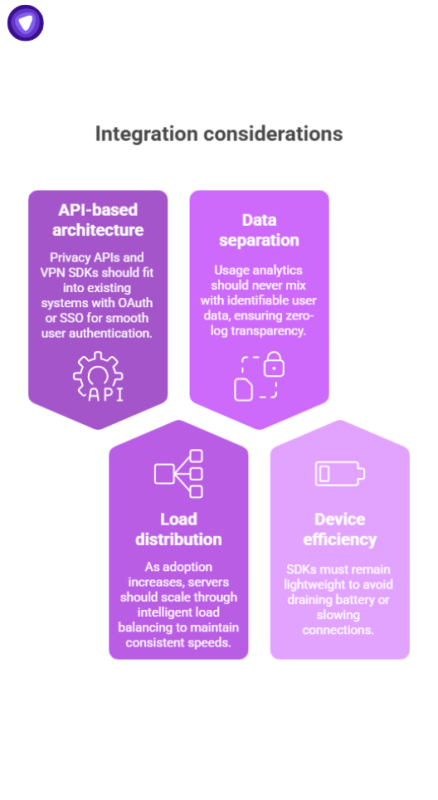
- API-based architecture: Privacy APIs and VPN SDKs should fit into existing systems with OAuth or SSO for smooth user authentication.
- Load distribution: As adoption increases, servers should scale through intelligent load balancing to maintain consistent speeds.
- Data separation: Usage analytics should never mix with identifiable user data, ensuring zero-log transparency.
- Device efficiency: SDKs must remain lightweight to avoid draining battery or slowing connections.
Start small with VPN and DNS integration for premium users. Once stability is proven, scale across larger customer bases and add breach monitoring or tracker blocking.
The Silent Churn Trigger – Privacy Fatigue and Fragmented Security
Telecom subscriber retention is often lost not because of poor service, but because of privacy fatigue. Users are tired of managing multiple privacy tools, each requiring separate setups, logins, and updates.
A study found that 42% of users abandon services when privacy settings feel inconsistent or complex. The lesson is simple: people want privacy, but they want it to work quietly in the background.
Why fragmentation hurts retention?
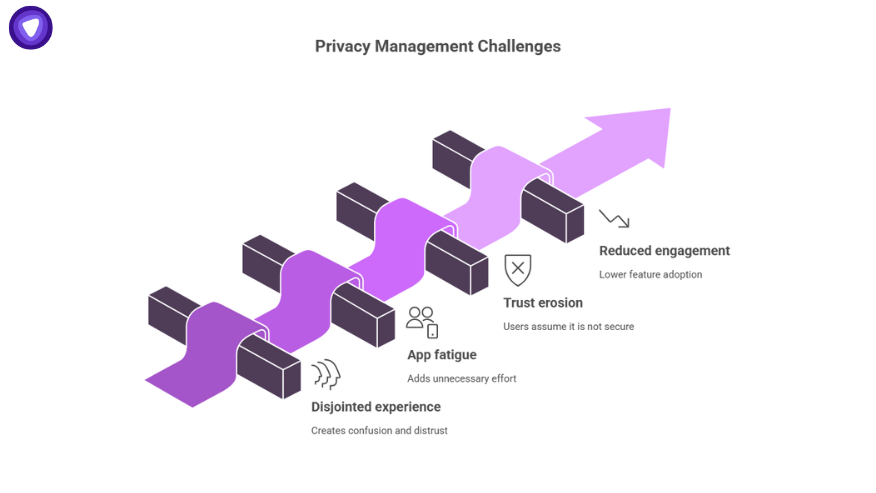
- Disjointed experience: Inconsistent privacy controls across devices create confusion and distrust.
- App fatigue: Managing separate VPN, DNS, and ad-blocking tools adds unnecessary effort.
- Trust erosion: If maintaining privacy feels complicated, users assume it is not secure.
- Reduced engagement: Complex interfaces and multiple logins lead to lower feature adoption.
The Retention Fix – Unified Privacy Ecosystems
A unified privacy suite provides a consistent, one-login experience across all devices.
Bundled privacy integrates VPN, DNS encryption, and anti-tracking under one system, creating simplicity that users value. For the backend, this means:
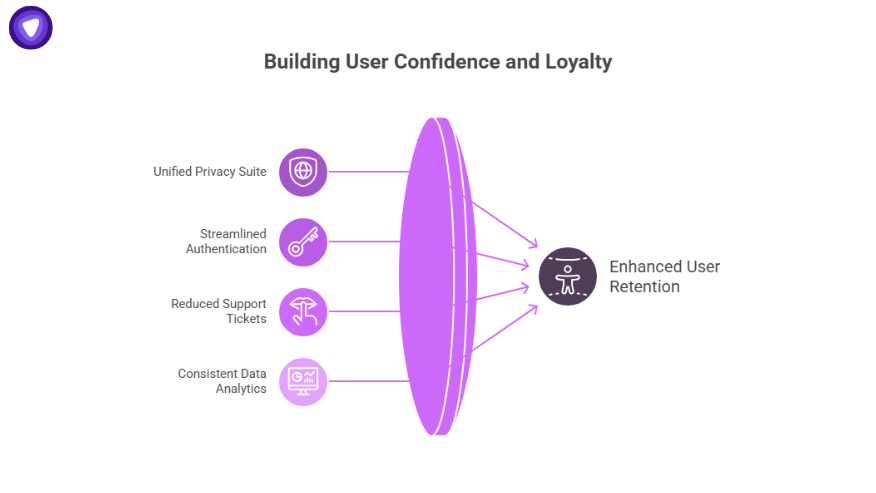
- Streamlined authentication across all privacy layers.
- Fewer support tickets related to setup issues.
- Consistent data for analytics without breaching privacy.
Unified privacy is not just a feature, it is a frictionless experience that strengthens user confidence and keeps them subscribed longer.
The Business Impact: Churn Reduction Through Built-in Privacy
Providers who bundle privacy into their service offerings see measurable improvement in telecom subscriber retention. It’s not theoretical, it’s reflected in the metrics.
Proven benefits
- Lower churn rates: McKinsey’s analysis shows up to a 22% reduction in churn among providers offering built-in privacy protection.
- Higher ARPU: Customers pay 15–25% more for services that include privacy tools they trust.
- Reduced acquisition pressure: Retained users drive word-of-mouth growth, lowering acquisition costs.
| KPI | Without Privacy Bundle | With Privacy Bundle |
| Annual Churn Rate | 28% | 18% |
| Average Revenue per User (ARPU) | $14.30 | $17.20 |
| Support Tickets per 1,000 Users | 54 | 27 |
When privacy is part of the core product, subscribers see long-term value. This shifts retention from a marketing battle to a built-in experience.
The Future of Telecom Subscriber Retention: Privacy as Default
Competition in the telecom sector has intensified. As pricing differences narrow, long-term retention will depend on trust. Privacy is the next differentiator.
In the near future:
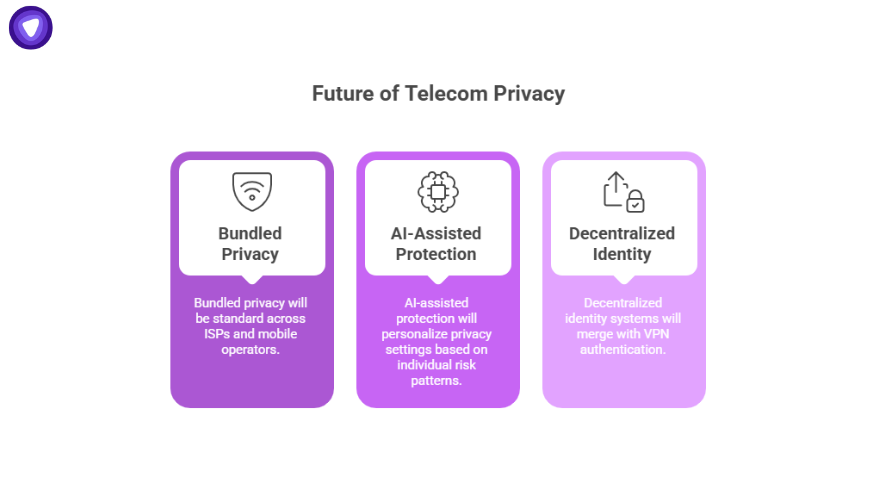
- Bundled privacy will be standard across ISPs and mobile operators.
- AI-assisted protection will personalize privacy settings based on individual risk patterns.
- Decentralized identity systems will merge with VPN authentication to create continuous, cross-platform privacy.
The providers who adopt bundled privacy early will set the standard for subscriber trust.
Why PureVPN White Label Fits the Retention Strategy
For providers planning to include privacy in their bundles, the challenge is often build versus buy. Building from scratch demands infrastructure, security audits, and development cycles that stretch timelines. Integrating a proven SDK or API framework solves this.
The PureVPN White Label solution allows telecom providers to launch branded privacy services that directly improve subscriber retention without heavy internal development.
Technical strengths
- Full SDK and API access for integration across apps, routers, or portals.
- Dedicated IP options for business and premium users.
- Global server coverage ensuring low latency.
- Modular design for branding flexibility and feature customization.
- Zero-log operations for compliance and transparency.
- 24/7 support for integration and maintenance.
Business benefits
- Launch a branded VPN or privacy suite in weeks, not months.
- Offer customers built-in privacy to boost loyalty and lifetime value.
- Reduce churn by embedding security into daily network use.
- Generate new revenue through tiered privacy plans.
By aligning privacy with performance and ease of use, PureVPN White Label helps telecoms turn trust into a measurable retention advantage.
Actionable Takeaways for Providers
- Treat privacy as a core service, not a perk. Customers expect it to be part of their plan.
- Unify protection across all devices. One subscription, one login, full coverage.
- Track retention metrics linked to privacy usage. Data will confirm its impact.
- Empower development teams with ready SDKs. Faster rollouts equal faster returns.
- Make privacy visible but effortless. Simple onboarding creates stronger engagement.
Final Thoughts
Telecom subscriber retention is not driven by discounts or promotions. It depends on how much users trust their provider with their data.
Bundled privacy delivers that trust at scale. It transforms a service from something users pay for into something they rely on.
With PureVPN White Label, telecom providers can embed privacy directly into their core offering, turning every secure connection into a reason to stay subscribed.


